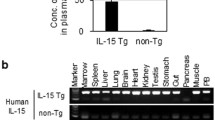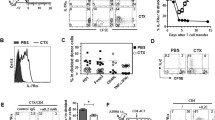Abstract
We have explored the use of an IL-21 cell-based anti-leukemia treatment in a mouse model of acute lymphoblastic leukemia. 70Z/3 leukemia cells, engineered to secrete IL-21 and injected into the peritoneum of syngeneic mice, induced a strong anti-leukemia response resulting in 100% survival. Mice that mounted an IL-21-induced anti-leukemia immune response were immune to the parent cell line (no IL-21) when rechallenged.
Above a certain threshold, IL-21 secretion correlated with improved survival compared to mice injected with parent 70Z/3 cells. IL-21 was detected in serum with peak levels on day 7, correlating with the maximum expansion of IL-21-secreting 70Z/3 cells which subsequently were eliminated. Mice injected with IL-21-secreting leukemia cells had elevated numbers of granzyme B+ CD4+ and CD8+ T cells in the peritoneum, compared to mice injected with the parent cell line. Regulatory T cells, which increased greatly in 70Z/3-injected mice, failed to do so in mice injected with IL-21-secreting cells. Upon rechallenge, IL-21-primed mice went through a secondary immune response, primarily requiring CD4+ T cells, triggering a significant increase of CD4+CD44+CD62L− effector memory T cells. Adoptive transfer of T cells from IL21-primed/rechallenged hosts into naïve mice was successful, indicating that IL-21-primed antigen-experienced T cells convey immunity to naïve mice.
Our study shows that delivery of IL-21 in a cell-based anti-leukemia protocol has the potential to induce a potent immune response leading to cancer elimination and long-term immunity—properties which make IL-21 an attractive candidate for cancer immunotherapy. Protecting against tumor antigens as well as improving cancer immunity is justified, as current strategies are limited.







Similar content being viewed by others
Abbreviations
- FCS:
-
Fetal calf serum
- GFP:
-
Green fluorescent protein
- GrzB:
-
Granzyme B
- hr:
-
hour
- IFN-γ:
-
Interferon-γ
- ip:
-
Intraperitoneal
- LV:
-
Lentivirus
- LVV:
-
Lentiviral vector
- ON:
-
Overnight
- PBS:
-
Phosphate-buffered saline
- vs:
-
versus
References
Floros T, Tarhini AA (2015) Anticancer cytokines: biology and clinical effects of interferon-alpha2, interleukin (IL)-2, IL-15, IL-21, and IL-12. Semin Oncol 42(4):539–548
Lee S, Margolin K (2011) Cytokines in cancer immunotherapy. Cancers (Basel) 3(4):3856–3893
Labbe A et al (2009) IL-12 immunotherapy of murine leukaemia: comparison of systemic versus gene modified cell therapy. J Cell Mol Med 13(8B):1962–1976
Nelles ME et al (2014) Murine splenic CD4(+) T cells, induced by innate immune cell interactions and secreted factors, develop antileukemia cytotoxicity. Cancer Immunol Res 2(11):1113–1124
Wei LZ et al (2013) Localized interleukin-12 delivery for immunotherapy of solid tumours. J Cell Mol Med 17(11):1465–1474
Berger A et al (2019) Interleukin-15 in cancer immunotherapy: IL-15 receptor complex versus soluble IL-15 in a cancer cell-delivered murine leukemia model. J Immunother Cancer 7(1):355
Croce M, Rigo V, Ferrini S (2015) IL-21: a pleiotropic cytokine with potential applications in oncology. J Immunol Res 2015:696578
Sondergaard H, Skak K (2009) IL-21: roles in immunopathology and cancer therapy. Tissue Antigens 74(6):467–479
Sharma A, Rudra D (2018) Emerging functions of regulatory T cells in tissue homeostasis. Front Immunol 9:883
Kim JH, Kim BS, Lee SK (2020) Regulatory T cells in tumor microenvironment and approach for anticancer immunotherapy. Immune Netw 20(1):e4
Chen MM et al (2016) Polarization of tissue-resident TFH-like cells in human hepatoma bridges innate monocyte inflammation and M2b macrophage polarization. Cancer Discov 6(10):1182–1195
Meng X et al (2018) Distribution of circulating follicular helper T cells and expression of interleukin-21 and chemokine C-X-C ligand 13 in gastric cancer. Oncol Lett 16(3):3917–3922
Davis MR et al (2015) The role of IL-21 in immunity and cancer. Cancer Lett 358(2):107–114
Paige CJ, Kincade PW, Ralph P (1978) Murine B cell leukemia line with inducible surface immunoglobulin expression. J Immunol 121(2):641–647
Jiang T, Zhou C, Ren S (2016) Role of IL-2 in cancer immunotherapy. Oncoimmunology 5(6):e1163462
Adeegbe DO, Nishikawa H (2013) Natural and induced T regulatory cells in cancer. Front Immunol 4:190
Najafi S, Mirshafiey A (2019) The role of T helper 17 and regulatory T cells in tumor microenvironment. Immunopharmacol Immunotoxicol 41(1):16–24
Kim-Schulze S et al (2009) Local IL-21 promotes the therapeutic activity of effector T cells by decreasing regulatory T cells within the tumor microenvironment. Mol Ther 17(2):380–388
Kannappan V et al (2017) Interleukin 21 inhibits cancer-mediated FOXP3 induction in naive human CD4 T cells. Cancer Immunol Immunother 66(5):637–645
Gowda A et al (2010) Differential effects of IL-2 and IL-21 on expansion of the CD4+ CD25+ Foxp3+ T regulatory cells with redundant roles in natural killer cell mediated antibody dependent cellular cytotoxicity in chronic lymphocytic leukemia. MAbs 2(1):35–41
Attridge K et al (2012) IL-21 inhibits T cell IL-2 production and impairs Treg homeostasis. Blood 119(20):4656–4664
Schmitz I et al (2013) IL-21 restricts virus-driven Treg cell expansion in chronic LCMV infection. PLoS Pathog 9(5):e1003362
Vogelzang A et al (2014) IL-21 contributes to fatal inflammatory disease in the absence of Foxp3+ T regulatory cells. J Immunol 192(4):1404–1414
Geri G et al (2011) Critical role of IL-21 in modulating TH17 and regulatory T cells in Behcet disease. J Allergy Clin Immunol 128(3):655–664
Sallusto F, Geginat J, Lanzavecchia A (2004) Central memory and effector memory T cell subsets: function, generation, and maintenance. Annu Rev Immunol 22:745–763
Silaeva YY et al (2013) Decrease in pool of T lymphocytes with surface phenotypes of effector and central memory cells under influence of TCR transgenic beta-chain expression. Biochemistry (Mosc) 78(5):549–559
Browning RL et al (2016) Lenalidomide induces interleukin-21 production by T cells and enhances IL21-mediated cytotoxicity in chronic lymphocytic leukemia B cells. Cancer Immunol Res 4(8):698–707
Bhatt S et al (2015) Direct and immune-mediated cytotoxicity of interleukin-21 contributes to antitumor effects in mantle cell lymphoma. Blood 126(13):1555–1564
Sondergaard H et al (2007) Interleukin 21 therapy increases the density of tumor infiltrating CD8+ T cells and inhibits the growth of syngeneic tumors. Cancer Immunol Immunother 56(9):1417–1428
Chapuis AG et al (2016) Combined IL-21-primed polyclonal CTL plus CTLA4 blockade controls refractory metastatic melanoma in a patient. J Exp Med 213(7):1133–1139
Chapuis AG et al (2016) T-cell therapy using interleukin-21-primed cytotoxic T-cell lymphocytes combined with cytotoxic T-cell lymphocyte antigen-4 blockade results in long-term cell persistence and durable tumor regression. J Clin Oncol 34(31):3787–3795
Ugai S et al (2003) Expression of the interleukin-21 gene in murine colon carcinoma cells generates systemic immunity in the inoculated hosts. Cancer Gene Ther 10(3):187–192
Ugai S et al (2003) Transduction of the IL-21 and IL-23 genes in human pancreatic carcinoma cells produces natural killer cell-dependent and -independent antitumor effects. Cancer Gene Ther 10(10):771–778
Nelles ME, Paige CJ (2015) CD4(+) T cell plasticity engenders robust immunity in response to cytokine therapy. Oncoimmunology 4(3):e994370
Oh DY et al (2020) Intratumoral CD4(+) T cells mediate anti-tumor cytotoxicity in human bladder cancer. Cell 181(7):1612–1625
Zhang L et al (2018) Lineage tracking reveals dynamic relationships of T cells in colorectal cancer. Nature 564(7735):268–272
Quezada SA et al (2010) Tumor-reactive CD4(+) T cells develop cytotoxic activity and eradicate large established melanoma after transfer into lymphopenic hosts. J Exp Med 207(3):637–650
Zander R et al (2019) CD4(+) T cell help is required for the formation of a cytolytic CD8(+) T cell subset that protects against chronic infection and cancer. Immunity 51(6):1028–1042
Funding
This work was supported by funding from the Leukemia and Lymphoma Society of Canada, the Toronto General and Western Hospital Foundation, and the Princess Margaret Cancer Centre Foundation through grants held by Dr. Paige.
Author information
Authors and Affiliations
Contributions
AB, SJC, and MZ designed, carried out, and/or analyzed in vitro and in vivo experiments. AB, SJC, MZ and CJP wrote the manuscript. All authors read, revised, and approved the final manuscript.
Corresponding author
Ethics declarations
Conflict of interest
The authors have no conflicts of interest to declare.
Additional information
Publisher's Note
Springer Nature remains neutral with regard to jurisdictional claims in published maps and institutional affiliations.
Rights and permissions
Springer Nature or its licensor (e.g. a society or other partner) holds exclusive rights to this article under a publishing agreement with the author(s) or other rightsholder(s); author self-archiving of the accepted manuscript version of this article is solely governed by the terms of such publishing agreement and applicable law.
About this article
Cite this article
Berger, A., Colpitts, S.J., Zych, M. et al. Engineered murine IL-21-secreting leukemia cells induce granzyme B+ T cells and CD4+CD44+CD62L− effector memory cells while suppressing regulatory T cells, leading to long-term survival. Cancer Immunol Immunother 72, 2597–2612 (2023). https://doi.org/10.1007/s00262-023-03442-2
Received:
Accepted:
Published:
Issue Date:
DOI: https://doi.org/10.1007/s00262-023-03442-2




